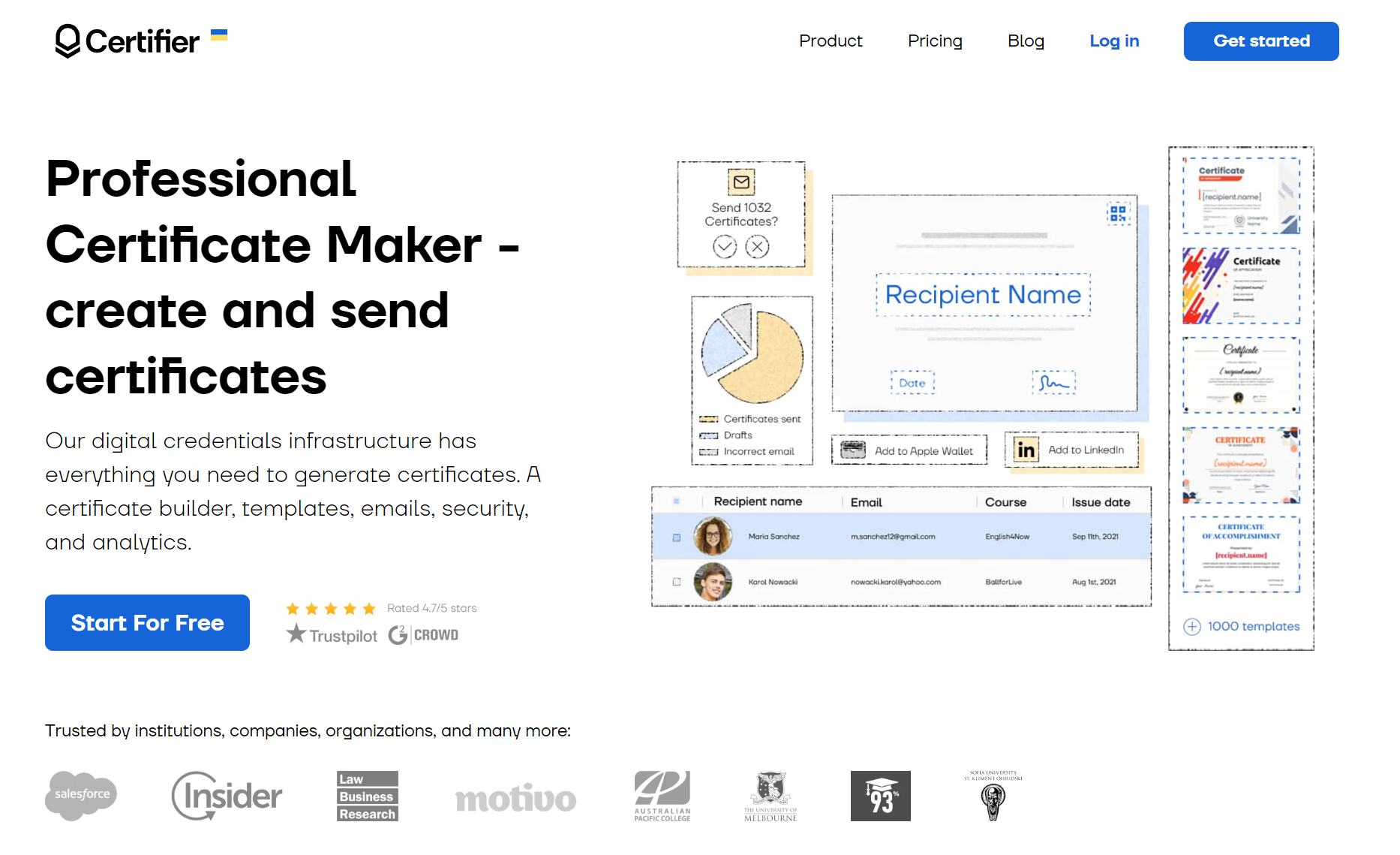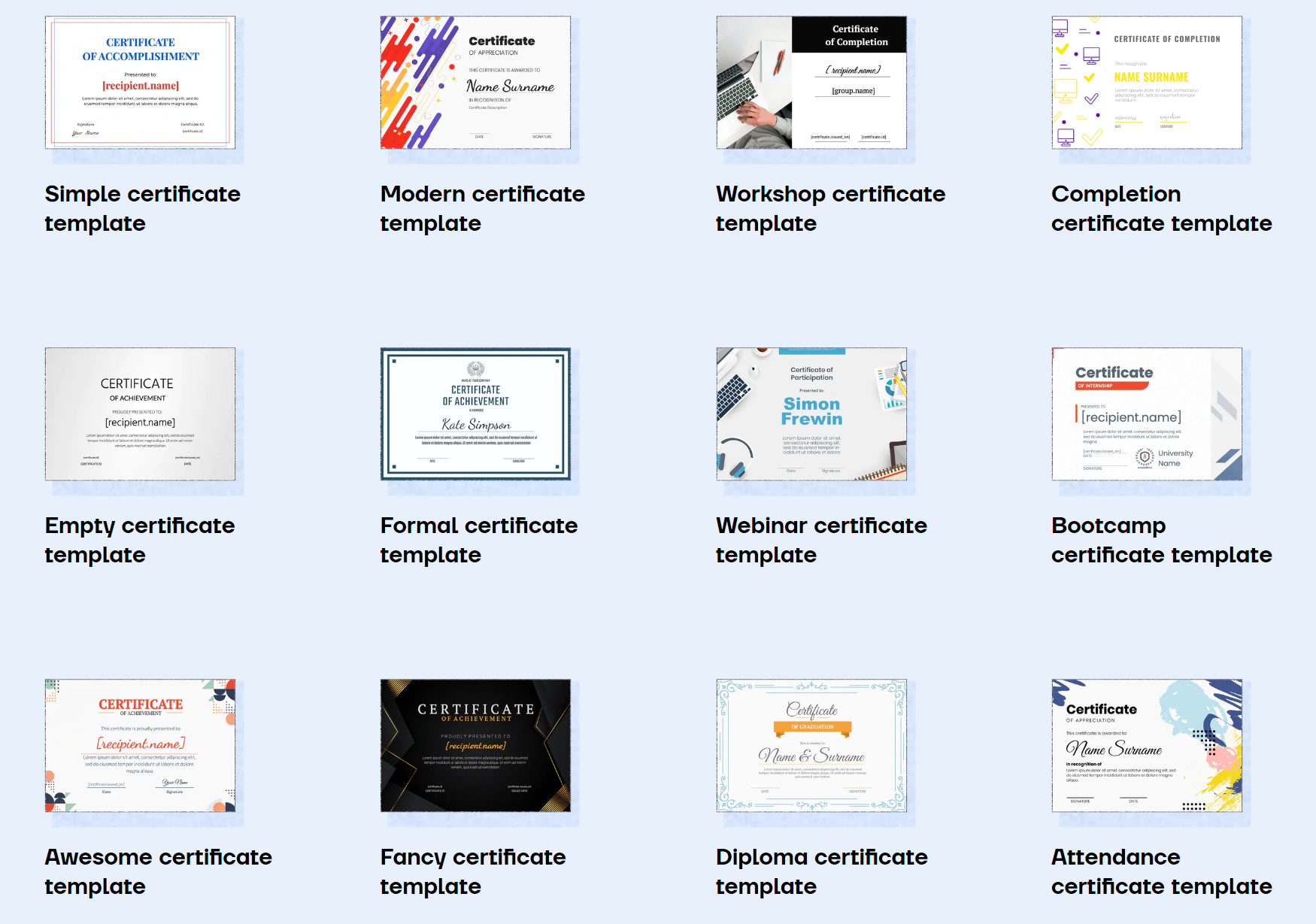Trusted by:
Updated: December 05, 2025
6 min read
8 Best Certificate Design Principles to Create a Lasting Impression in 2026
Do you want to create a certificate that makes a lasting impression on its recipients? Today we will discuss how to do this. Spoiler alert: in 2026, you can make it for free and in a blink of an eye!
A great certificate isn’t just a piece of paper—it’s a statement of achievement, a reflection of your brand, and a lasting reminder of success. Whether you’re recognizing hard work, celebrating milestones, or promoting your organization, the right design makes all the difference
In this guide, Certifier will explore eight powerful tips to craft certificates that impress, inspire, and elevate your brand. Let’s turn your next certificate into something truly unforgettable!
TL;DR
Good certificate design boosts credibility, visibility, and brand recognition.
Clean layouts, strong typography, high-quality visuals, and brand-aligned colors.
Templates help you create polished designs fast; Certifier makes issuing and managing them easy.
Certifier also supports bulk sending, verification, printing, and secure data handling.
Why is certificate design so important?
Before we dive into the design principles, let’s hit pause for a second.
Certificate design carries more than just visual appeal—it’s a strategic asset that amplifies your brand and elevates every achievement you issue. Here’s what strong design can do for you:
Boost marketing and engagement: Certificates are inherently shareable. A well-designed one inspires recipients to showcase their achievements on LinkedIn and other platforms—promoting your brand in the process.
Enhance recognition and recall: Clean hierarchy, typography, and layout help your certificates stand out and make your organization instantly memorable.
Build trust and authenticity: Professional, verifiable designs (with QR codes or issuer badges) signal credibility and strengthen your brand’s reliability.
So, before discussing layouts and templates, remember: the way your certificate looks isn’t just an aesthetic choice—it’s a strategic one.
What are some of the best certificate design principles?
Now, as we established the goal for a well-designed certificate, it's time to explore the main principles. Through years of experience with certificate design, our team established seven core rules that work best:
#1 Create a scannable layout
Before you start designing, take a moment to plan the layout. Even a simple sketch can help you visualize how key information will appear on the page.
A well-designed certificate should be easy to scan—important details like the recipient’s name, award title, and issuing organization should stand out at first glance. If you’re unsure about the balance or readability, ask a colleague for feedback—fresh eyes can often spot what you might miss.
#2 Keep your certificate professional and clean
A professional, uncluttered layout immediately sets the right impression. A clear, streamlined layout ensures the focus stays on what matters most: the achievement being recognized. And the best part? You don’t need to be a designer to achieve this—just a keen eye for clarity and consistency.
Tip: Pay attention to visual balance—consistent font sizes, quality imagery, and harmonious color choices all contribute to a cohesive look. Avoid overcrowding your design with too many elements.
#3 Add high-quality images
Images can elevate your certificate design—but only when used thoughtfully. Low-resolution or poorly chosen visuals can make an otherwise polished certificate appear unprofessional. Always select high-quality images or graphics that complement the overall style.
#4 Use typography strategically
In short, typography design is the art of arranging type to make written language readable. You make the message aesthetically pleasing and readable.
Typography involves:
choosing typefaces
point size
line length
line spacing
letter spacing
Typography is great when you want to emphasize a piece of important information, such as the recipient's name, company name, or why they are being rewarded. Don’t be afraid to make some more extensive fonts, but keep it organized and readable.
#6 Design a printable certificate
Even if you design certificates to be primarily digital, making them printable adds real value. Many recipients still prefer to display their achievements physically—on an office wall or in a portfolio. Ensuring your design is print-friendly shows attention to detail and elevates the perceived quality of your brand.
Want a step-by-step walkthrough? Check out our guide on how to create a printable certificate and learn how to make your digital designs look flawless on paper.
#7 Use color to add visual interest and contrast
Colors play a vital role in certificate design. Beyond aesthetics, they guide the viewer’s attention, highlight key information, and reinforce your brand identity. Thoughtful use of color can transform a simple certificate into a visually engaging and memorable document.
Choose colors that align with your brand palette or the theme of your event or course. For instance, a water safety or marine program might use calming blue tones to subtly reflect its subject matter.
#8 Use templates to streamline your design process
Even with all the right design principles, creating certificates from scratch can still be time-consuming. Templates provide a solid foundation—helping you maintain professional quality while saving valuable time.
High-quality templates allow you to customize colors, typography, and layouts to match your brand, ensuring every certificate you issue looks polished and consistent. They’re especially useful when you need to issue certificates at scale, eliminating repetitive design work while keeping your visual identity intact.
Master your certificate designs with Certifier
Certifier is an excellent tool for designing certificates for any occasion you need. So no matter whether you want to create an awards certificate, gift certificate, or maybe recognition, appreciation, or even an employee of the month certificate, Certifier will help you stay on top.

Here are over 30 ideas for certificates from Certifier. Read the article if you need some inspiration.
Thanks to many features, you can easily implement all the principles we’ve covered.
So let’s look at how Certifier works and what it offers!
01 Using free certificate templates (fully editable and easily customizable)
With a massive library of templates, you can choose a template you like and change the landscape orientation, colors, background – whatever you like.
Some good news here – Certifier provides free fonts. Also, all the elements are adjustable and editable – feel free if you want to tweak anything up. Add your logo, and visual elements, or sign it digitally. It’s all up to you.

02 Creating certificates from scratch
Thanks to certificate builders, making certificates, diplomas, or other credentials from scratch is a piece of cake. You can upload your own background and then all the elements. However, if you don’t have a background image, you can choose the certificate design that appeals to you the most and then remove all the text boxes with a single click. And now your background is ready for further changes!
03 Sending certification in bulk
Once you have your modern certificate designed, it’s time to print or send it to the recipients. With Certifier, it can take minutes!
Learn more about creating a certificate design quickly with our guide on how to make certificates in 15 minutes!
You can send certificates in bulk can be done in simple steps:
Log in to Certifier (if you don’t have the account yet, click here to sign up)
Prepare a CVS file with the recipients’ names and email addresses
Design the documents or use a modern certificate template
Upload the list and make a group
Send!
As simple as that. It is impossible to send credentials automatically when using programs like MS Word or Adobe Illustrator. But it is with Certifier!
04 Delivering verifiable documents
Besides providing many impressive certificates template and sending them in bulk, Certifier makes documents verifiable thanks to QR codes and verified issuer icons. So there’s no need to worry about falsifying certificates.
05 Sharing on social media
Shares on social media mean making a long-lasting impression on more people! After receiving a certificate award (or any other certificate type), your course attendees will be able to post them on social media, such as:
X
Those mentioned above can be tracked in your dashboard. In addition, you see social media insights like how many attendees added certificates on LinkedIn and how many shares there are on the rest of the social media channels.
06 Building printable certificates
With Certifier, you save money and time and create impressive certificates without learning how to design such documents. Moreover, compared to other tools such as Microsoft Word or Adobe Illustrator, Certifier provides you with simple yet powerful capabilities.
07 Managing certificates after sending
Have you sent the certificates, and it turned out there was a typo? You can edit sent credentials at ease. And you don’t need to design the template again. In your admin panel, you can:
Renew certificates
Resend them
Edit credentials
Delete if needed
08 Storing your data in a secure place
Certifier is GDPR compliant. It is s a set of regulations for protecting digital data privacy. So you don’t need to worry about the security and confidentiality of all your private information.
Implement all the certificate design principles with Certifier!
Certifier is a perfect tool for educational institutions, companies of any size, or private use. It’s ideal for rewarding for hard work, completion of the course, participation in training, or expressing appreciation for some other achievements and events. With many customization options, your certificate or diploma will stay with the recipients for a long.
Sign up for free to create a lasting impression with certificate design!
FAQ about certificate design principles
Here's the list of the most common questions about certificate design principles.

- SaaS Growth
- Digital Credentials
- APIs
- Product Marketing
- Company Operations
CEO and Co-Founder
Sergey is CEO and Co-Founder of Certifier, a Forbes 30 Under 30 honoree building digital credential infrastructure for 2,000+ organizations worldwide and shaping the future of credentialing.
